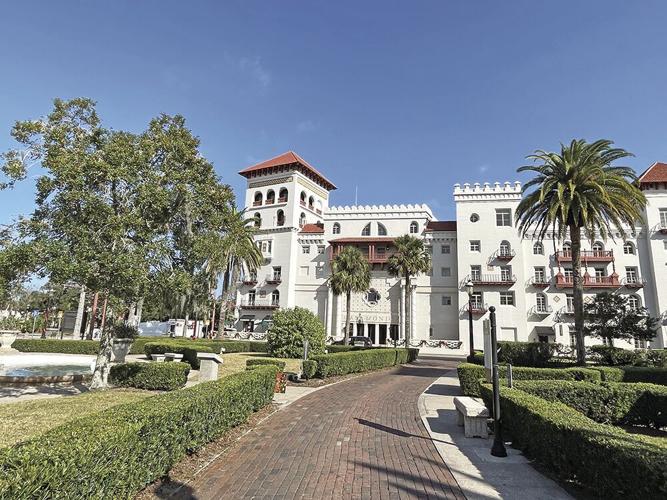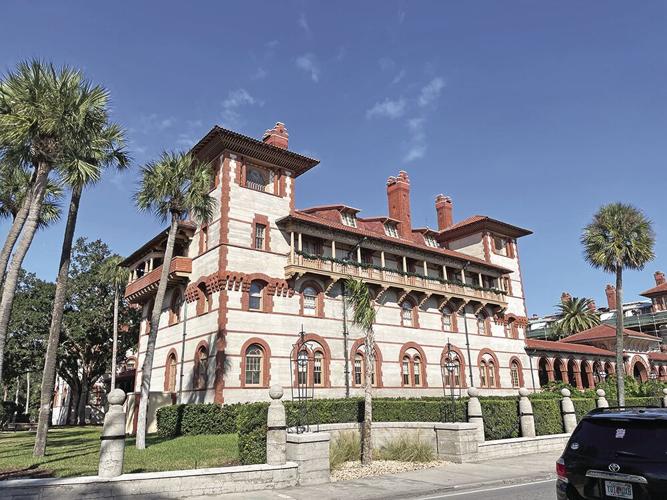America’s Oldest City
Normally, I am not much of a beer drinker, but we had walked quite a bit, I had suffered through a fair amount of window shopping, and it was quite a warm day. Therefore, a refreshing pale ale was perfect as we watched people strolling along St. George Street from the terrace of The Bull and Crown Public House.
One could easily be in an old European city. Narrow cobblestone alleys, mostly pedestrian, with cozy terraced cafes and small restaurants, could be found around every corner. Museums abound, as well as multiple shops, including the San Sebastian Winery housed in an old East Coast Railway building station offering wines and their own liquors known across the United States. Welcome to St. Augustine, Florida, the oldest city in North America. Tourists visit from all over the world, and it is “high season” every day of the year.
Juan Ponce de Leon, who was the Spanish governor of Puerto Rico at the time, discovered Florida in 1513.
The city of St. Augustine was founded in 1565, over 40 years before the English Colony of Jamestown, but it was almost destroyed by the English fighting Spain in 1702. The impressive fort, Castillo de San Marcos, constructed on the water’s edge in the center of St Augustine to protect the city, survived.
The city center, originally designed by Spanish Governor Gonzalo de Canzo, is dominated by historic buildings. Some of the best known are within two blocks of each other such as Flagler College, Hotel Casa Monica, the Alcazar, and Hotel Villa Zorayda. The ancient fort overlooks the picturesque harbor inlet and over 30 other historic buildings and at least as many replicas are built in the old style throughout the city. The first hotel was built by Henry Morrison Flagler and John Rockefeller in 1888 as the Ponce de Leon Hotel for New Yorkers to overwinter in the balmy Florida climate. The Spanish Renaissance style was designed by young architects right out of college, John Carrere and Thomas Hastings. Hastings also built the New York Public Library, as well as the House and Senate Office Building in Washington. The hotel was the first concrete construction in the United States poured in place and a first with 4,000 electric lights and steam heat. In 1968 it was incorporated as a National Historic Landmark centerpiece under the name of Ponce de Leon Hall in the new Flagler Liberal Arts College for women. In 1971 the college switched to coed education.
The venerable Casa Monica Hotel is the place to stay, located right across from Flagler College. It is one of the Historic Hotels of America, built by Boston hardware tycoon Franklin W. Smith, functioning today in all its classic luxury, and operated by Marriott. Smith bought the land from Flagler and opened his hotel a year before the Ponce de Leon Hotel. Flagler thought it would only bring more business to his railroad, but when his own hotel opened, Casa Monica was considered only number two, resulting in a lack of bookings. Regretfully, Smith did not have Flagler’s expertise in hotel management, and soon his finances were in such a sorry state that he sold not only the building, but everything in it for $325,000 to Flagler, who renamed it Hotel Cordova which operated until 1932. Subsequently, it functioned as the St Augustine Courthouse for another 40 years. In 1999 the building was purchased by the Kessler Hotels Collection and reopened as Casa Monica operated by Marriott. A few years ago, it became part of the Marriott Autograph Collection. Their guests have included such diverse dignitaries as King Juan Carlos I of Spain, Desmond Tutu and Bill Clinton.
The Hotel Alcazar across the street was also constructed in the same time frame by Flagler, and in 1902 he even built a bridge between the two hotels that was later destroyed. Today it is the Lightner Museum, named after Otto Lightner, and it houses his 50,000-piece antique collection. Villa Zorayda, almost next door, was inspired by the Moorish architecture of the Alhambra Palace in Spain. Between 1891 and 1953 it even served as the local jail. As exquisite as it is, it is difficult to imagine that it could have served as a jail.
For several years I have been lucky enough to enjoy short stays in St Augustine on a regular basis. One of my sons chose St Augustine as his home until recently moving to Maine. He and his wife purchased an old boarding house and barbershop in Lincolnville, which was the historically Black neighborhood in the center of town dating back to segregation. In 1964 it became a center for the Civil Rights Movement. Over the last years the original small homes, many on stilts, have been rebuilt, changing the character in this part of St. Augustine considerably. Strolling across town on St George Street and many of the narrow cross alleys one passes numerous restaurants, cafes and a variety of small shops. The 18th-century schoolhouse that was opened during the Spanish occupation was built exclusively with wood, wooden pegs, and handmade nails. The last students graduated from this one-room school in 1864.
In addition to the previously mentioned architecture, there is the Fountain of Youth on picturesque Magnolia Street. According to archaeological discoveries, the Indians lived there 3,000 years ago. The St. Augustine Lighthouse and Maritime Museum across the Lions Bridge on Anastasia Island is also worth a visit. Built around 1870 by the Spanish, it is still functioning as a navigational marker for the port of St. Augustine. The Lions Bridge is flanked by two lions made from Carrera marble and is an excellent spot to view the city of St Augustine and the bay that forms the harbor. Last, but not least, there is “Ripley’s Believe it Or Not,” opened in 1958 which houses 19 galleries with some 300 exhibits.
From all the above attractions visiting St. Augustine without missing something important might sound a bit daunting. Therefore, I suggest beginning with a ride on the Hop-On-Hop-Off trolley to get an encompassing first impression.
Ewout Rijk de Vries and his wife, Jill, brought America Travel Arrangements to Marco Island almost 40 years ago. They specialize on high end small adventure tours and small safari groups for clientele all over the world, but also are experts on high end cruises with the help of longtime assistant and friend, Michelle Wegman. In combination with his writing and photography, Ewout has visited over 90 countries. Please direct your comments or questions to ewout@photodevries.com as he likes to hear from readers.
Read More:America’s Oldest City








